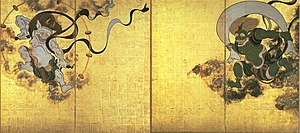Kennin-ji
This article includes a list of references, related reading, or external links, but its sources remain unclear because it lacks inline citations. (June 2014) |
| Kennin-ji 建仁寺 | |
|---|---|
 | |
| Location | |
| Country | Japan |
| Website | |
| http://www.kenninji.jp/ | |
Kennin-ji (建仁寺), is a historic Zen Buddhist temple in Higashiyama, Kyoto, Japan, near Gion, at the end of Hanami Lane. It is considered to be one of the so-called Kyoto Gozan or "five most important Zen temples of Kyoto".
History

Kennin-ji was founded in 1202 CE and claims to be the oldest Zen temple in Kyoto.
The monk Eisai, credited with introducing Zen to Japan, served as Kennin-ji's founding abbot and is buried on the temple grounds. For its first years the temple combined Zen, Tendai, and Shingon practices, but it became a purely Zen institution under the eleventh abbot, Lanxi Daolong (蘭渓道隆, Rankei Dōryū) (1213–1278).
The Zen master Dōgen, later founder of the Japanese Sōtō sect, trained at Kennin-ji. It is one of the Rinzai sect's headquarter temples.
Architecture

an Important Cultural Property of Japan
When first built, the temple contained seven principal buildings. It has suffered from fires through the centuries, and was rebuilt in the mid-thirteenth century by Zen master Enni, and again in the sixteenth century with donations of buildings from nearby temples Ankoku-ji and Tōfuku-ji.
Today Kennin-ji's buildings include the Abbot's Quarters (Hōjō), given by Ankoku-ji in 1599; the Dharma Hall (Hatto), built in 1765; a tea house built in 1587 to designs by tea master Sen no Rikyū for Toyotomi Hideyoshi; and the Imperial Messenger Gate (Chokushimon), said to date from the Kamakura period, and still showing marks from arrows. It also has 14 subtemples on the Kennin-ji precincts and about 70 associated temples throughout Japan.
In 2002, the architectural setting was enhanced by a dramatic ceiling painting of two dragons by Koizumi Junsaku. This bold artwork was installed to commemorate the temple's 800th anniversary.
Artworks

Kennin-ji contains notable paintings by Tamura Sōryū[citation needed] and Hashimoto Kansetsu. Fujin and Raijin, a pair of two-fold screens by Tawaraya Sōtatsu, currently on display at the Kyoto National Museum.
See also
- List of Buddhist temples in Kyoto
- List of National Treasures of Japan (paintings)
- For an explanation of terms concerning Japanese Buddhism, Japanese Buddhist art, and Japanese Buddhist temple architecture, see the Glossary of Japanese Buddhism.
Notes
References
- Baroni, Helen Josephine. (2002). The Illustrated Encyclopedia of Zen Buddhism. New York: Rosen Publishing Group. 10-ISBN 0-8239-2240-5; 13-ISBN 978-0-8239-2240-6; OCLC 42680558
- Dumoulin, Heinrich. (2005). Zen Buddhism: A History (Vol. II: Japan). Bloomington, Indiana: World Wisdom. 10-ISBN 0-941532-90-9; 13-ISBN 978-0-941532-90-7
- Kennin-ji: The Oldest Zen Temple in Kyoto, undated brochure from temple
- Ponsonby-Fane, Richard Arthur Brabazon. (1956). Kyoto: The Old Capital of Japan, 794-1869. Kyoto: The Ponsonby Memorial Society.
